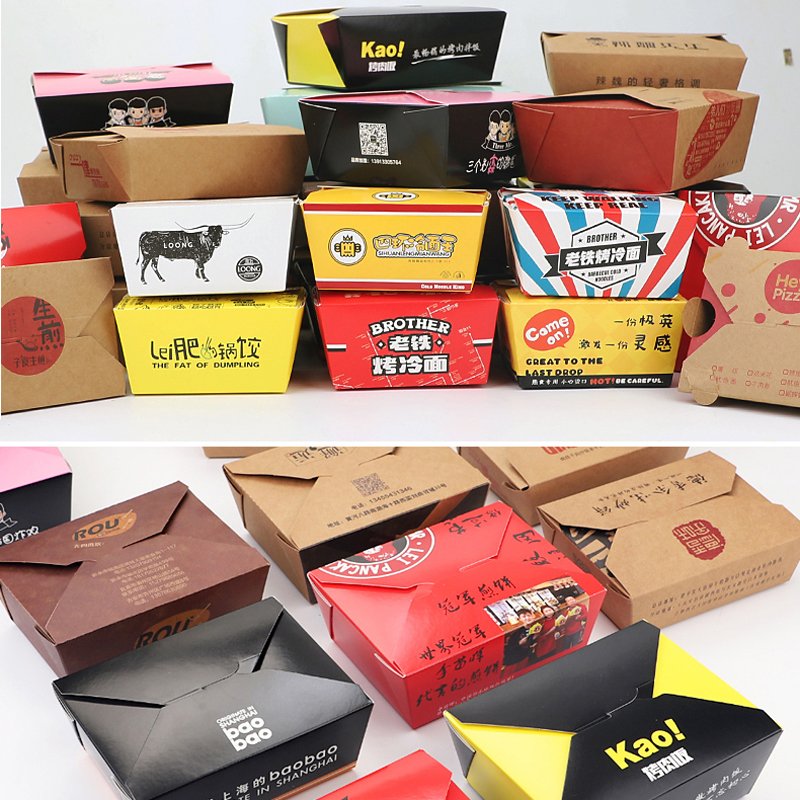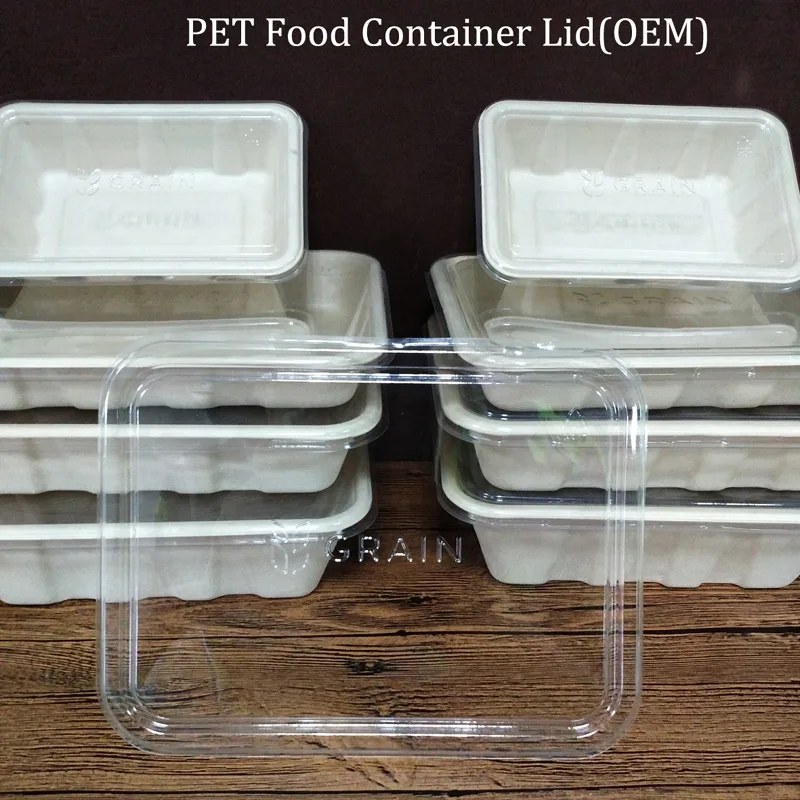In today’s highly competitive fast-food market, food quality alone no longer guarantees customer loyalty. Personalized fast food packaging serves as an influential brand differentiator, enhancing consumer experience and ensuring brand recall. This comprehensive guide explores different packaging types, their production processes, and practical insights on customizing fast food packaging effectively.
Types of Fast Food Packaging
Fast food packaging serves multiple purposes: preserving food quality, ensuring safety during transport, and providing a medium for branding and communication. The choice of packaging material significantly influences these factors. Below is an expanded overview of common packaging materials used in the fast food industry:
1. Paper-Based Packaging
Materials: Paperboard and corrugated cardboard are widely utilized for items such as burger boxes, French fry containers, and drink cups.
Productieproces: These materials are processed from wood pulp, formed into sheets, and then cut and folded into desired shapes.
Kenmerken:
- Structural Integrity: Provides adequate support for various food items.
- Recyclability: Easily recyclable, contributing to environmental sustainability.
- Customization: Offers a printable surface for branding and design elements.
Example: Many fast food chains use paperboard cartons for packaging sandwiches and fries, leveraging the material’s sturdiness and printability to enhance brand visibility.


2. Plastic-Based Packaging
Materials: Common plastics include Polyethylene Terephthalate (PET) and Polystyrene (PS).
Productieproces: Plastics are molded into various shapes through processes like thermoforming and injection molding.
Kenmerken:
- Duurzaamheid: Resistant to moisture and physical damage.
- Veelzijdigheid: Suitable for a wide range of food products, both hot and cold.
- Transparency: Allows visibility of the food item, enhancing presentation.
Example: Clear PET containers are often used for salads and cold beverages, offering an appealing display of the contents.


3. Biodegradable and Compostable Packaging
Materials: Derived from renewable resources like maïzena, suikerrietbagasse, bamboo pulp, and wood pulp.
Productieproces: These materials are pulped, molded, and dried into various packaging forms.
Kenmerken:
- Milieuvriendelijk: Breaks down naturally, reducing environmental impact.
- Heat Resistant: Suitable for hot food items.
- Consumer Appeal: Aligns with growing consumer preference for sustainable options.
Example: Compostable fiber containers made from bamboo pulp can withstand temperatures up to 110°C and decompose naturally when buried in soil.


4. Foam Packaging
Materials: Expanded Polystyrene (EPS) foam is commonly used for items like clamshell containers and drink cups.
Productieproces: EPS beads are expanded and molded into specific shapes.
Kenmerken:
- Insulation: Excellent at maintaining food temperature.
- Lightweight: Easy to handle and transport.
- Kosteneffectief: Generally less expensive to produce.
Example: Foam clamshells are frequently used for takeout meals, keeping food warm during transport.
How is Fast Food Packaging Made?
The production of fast food packaging involves several meticulous steps to ensure functionality, safety, and visual appeal. Here’s a detailed breakdown of the process:
1. Material Selection
Choosing the appropriate material is foundational. Factors considered include:
- Food Compatibility: Ensuring the material is safe for direct food contact.
- Duurzaamheid: Ability to withstand handling and transportation without compromising integrity.
- Sustainability: Preference for materials that are recyclable or biodegradable to minimize environmental impact.
2. Design and Prototyping
This phase focuses on creating packaging that aligns with brand identity and meets functional requirements:
- Structural Design: Developing shapes and sizes that accommodate specific food items.
- Aesthetic Elements: Incorporating brand colors, logos, and other design features.
- Prototyping: Producing sample packaging to test for usability, durability, and visual appeal before mass production.
3. Manufacturing Process
The production process varies based on the chosen material:
- Paper-Based Packaging:
- Printing: Applying designs and branding elements onto large paper sheets.
- Cutting and Creasing: Precision cutting into specific shapes and adding fold lines.
- Folding and Gluing: Assembling the cut pieces into final packaging forms.
- Plastic-Based Packaging:
- Thermoforming: Heating plastic sheets and molding them into desired shapes.
- Injection Molding: Injecting molten plastic into molds to create specific forms.
- Cooling and Trimming: Solidifying the plastic and removing excess material.
- Biodegradable Packaging:
- Verpulpen: Breaking down natural fibers into a slurry.
- Vormen: Shaping the pulp into molds under heat and pressure.
- Drying and Finishing: Removing moisture and refining the final product.
4. Quality Control
Ensuring the packaging meets stringent standards involves:
- Durability Testing: Assessing resistance to tearing, crushing, and other physical stresses.
- Safety Checks: Verifying materials are free from harmful substances and safe for food contact.
- Consistency: Ensuring uniformity in size, shape, and design across production batches.
5. Distribution
Once production and quality control are completed, packaging is organized, packaged securely, and shipped directly to the food service provider. Efficient logistics ensures timely delivery, preserving the integrity of the packaging until it reaches end-users.
Custom Fast Food Packaging for Your Brand
Customized packaging is essential for building a memorable and competitive fast food brand. It transforms standard packaging into a powerful marketing tool that communicates your brand’s identity, values, and commitment to quality.
Benefits of Customized Packaging
- Increased Brand Recognition:
Customized food packaging prominently features your brand logo, colors, and unique design elements, creating an instant connection with consumers. - Enhanced Customer Experience:
Personalized packaging adds value by making consumers feel that they are receiving a premium, thoughtfully prepared product. - Competitive Differentiation:
Customization allows your brand to distinguish itself clearly from competitors, particularly in crowded fast food markets. - Positive Environmental Impact:
Opting for sustainable customized packaging (such as biodegradable bagasse) enhances brand reputation and appeals to eco-conscious consumers.
Key Strategies for Effective Packaging Customization
To maximize the impact of custom fast food packaging, consider the following strategies:
- Brand-Aligned Design
- Ensure that packaging visuals (logos, colors, typography) consistently reflect your brand identity and marketing strategy.
- Functional Innovation
- Create packaging designs that are not only visually appealing but also practical and user-friendly, such as built-in handles, resealable lids, or compartments.
- Storytelling and Messaging
- Use packaging as a storytelling platform to communicate your brand’s values, sustainability efforts, or unique selling propositions.
- Material Choices
- Selecting high-quality, sustainable materials (e.g., bagasse, PLA, recycled paper) positions your brand as environmentally responsible, meeting consumer expectations.
- Interactive Packaging Elements
- Incorporate QR codes, social media handles, or contests directly on packaging to engage customers digitally and encourage repeat business.
Practical Examples and Customer Insights
Case Study 1: Bioleader’s Packaging in Practice
Bioleader’s customized fast food packaging boxes have been successfully utilized by FreshExpress, a prominent U.S.-based fast-food chain. Their branded, eco-friendly food boxes, made from sustainable bagasse, received excellent feedback for their superior quality, leak resistance, durability, and appealing design. According to FreshExpress, adopting customized packaging increased customer satisfaction ratings by 35%, improved brand recall significantly, and led to a steady increase in repeat orders.
Case Study 2: Café Greenhouse Sustainability Initiative
Another success story is Café Greenhouse, a UK-based cafe, which switched to customized biodegradable paper boxes. Customers praised the cafe’s clear commitment to sustainability, which translated into a 20% boost in monthly sales and substantial online engagement, enhancing the brand’s market positioning.
Frequently Asked Questions (FAQs):
- 1. Why should brands invest in custom fast food packaging?
Customized packaging significantly improves brand visibility, boosts customer loyalty, and sets your products apart from competitors.
- 2. What is the most eco-friendly packaging material for takeaway food?
Bagasse (sugarcane-based), recycled paper, and PLA (polylactic acid) are currently the best sustainable packaging materials.
- 3. How much does custom packaging typically cost?
Cost varies by design complexity and material but generally represents a worthwhile investment due to increased brand visibility and customer retention.
- 4. How can I ensure the quality of customized packaging?
Partner with experienced, reputable packaging manufacturers who follow stringent quality control standards, conduct material tests, and offer certification for food safety compliance.
- 5. How long does custom packaging production take?
Typically, from design to final production, custom packaging can take between 4-8 weeks, depending on the complexity and quantity ordered.
Conclusion: Amplifying Your Brand with Customized Fast Food Packaging
Effective customized fast food packaging goes beyond mere practicality; it profoundly impacts brand perception, customer loyalty, and market differentiation. By choosing suitable materials, implementing innovative design, and ensuring consistent branding, your custom packaging can become an influential marketing asset that helps secure long-term business growth.
Reference Source List:
- McKinsey & Company, “Sustainability in Packaging: Global Regulatory Developments,”
- Deloitte, “The Future of Packaging: Smart, Personalized, and Sustainable,”
https://www2.deloitte.com/ - Smithers Research, “The Future of Food Service Packaging to 2028,”
https://www.smithers.com/services/market-reports/packaging/the-future-of-food-service-packaging - Packaging Gateway, “Sustainable Packaging Trends for Fast Food Brands,”
https://www.packaging-gateway.com/articles/sustainable-packaging-fast-food-brands - Environmental Protection Agency (EPA), “Reducing Food Packaging Waste,”
https://www.epa.gov/sustainable-management-food/reducing-food-packaging-waste - Foodservice Packaging Institute (FPI), “Trends in Foodservice Packaging,”
https://www.fpi.org/resources/trends-in-foodservice-packaging - Chris Stokel-Walker, “The War on Plastic Packaging,” BBC Future,
https://www.bbc.com/future/article/20230106-how-packaging-affects-our-food-and-environment - Emily Holbrook, “Packaging’s Role in Consumer Experience and Loyalty,” Packaging Digest.”
- Enpak Packaging, “Comprehensive Guide to Food Packaging Materials.”



